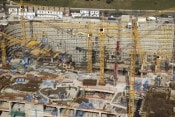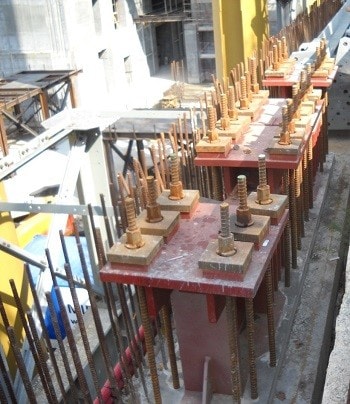
A panoramic view of chemical anchors in steel plate and post-installed rebar connections

How many fixing technologies have you heard about for connecting an anchor plate or a new concrete element to an existing one? Undoubtedly quite a few, however when it comes to safety-relevant or heavy-duty applications, injection mortars often feature in the short list of candidates.
Technically sound regulation framework (from qualification to design), flexibility, reliability and high bond strength (for high-quality products) are the main reasons why bi-component injection mortars are preferred over other solutions such as grouting.
Whether you are already familiar with this system or not, before drilling down into different adhesive alternatives (epoxy, hybrid, polyesters), there are some things you should know about the way chemical anchors are capable of transferring loads to a concrete element.
The principle: adhesion and interlock
It is possible to understand the way a chemical anchor works by observing the installation method. You might be surprised that it is not only about adhesion.
The installation of an anchor starts with the drilling of the base material, which is usually done by rotary hammer machines. The hammer drill bit penetrates the concrete, providing a hole of a controlled size and a rough surface.
· For the adhesion to take place, the hole must first be cleaned by blowing the dust out (manually or using a professional method) and brushing according to the product's user manual. However, the adhesion is not always the only means of transferring the load: A shape-resistant mechanism such as interlock can occur to bind to the materials.
Interlock is achieved through the micro-keying of the chemical anchorage on the rough surface of the drilled hole. Be advised that in the case of diamond drilling/coring (i.e. larger anchor sizes or embedment or densely reinforced concrete), the drilled hole surface will be too smooth for the interlock to occur. Not all injection mortars work under this condition and you should check the approval (such as the European Technical Assessment (ETA) approval document) to see if this case is covered and perform the design accordingly.

Once the mortar is injected, the threaded rod (or rebar) is inserted into the hole according to the working time of the product. Adhesion and interlock will occur on the threaded (in case of rod) or ribbed (on rebar) surface.
When the mortar has hardened (the curing time depends on the product), you can position the anchor plate and tighten the nut or cast the new concrete element in the formwork in the case of rebar.
Applications
Injection mortars can be used for anchor plate applications, especially when the fixing requires an embedment depth beyond the application range of mechanical anchors. A deeper embedment is needed to engage a bigger volume of concrete under the fixing. For the same reason, chemical anchors are also used for heavy non-structural applications. It is also one of the best solutions for post-installed rebars.

Qualified injection mortars can be used
for heavy-duty steel anchor plate applications
and concrete-to-concrete connections
Concerns about reliability?
When it comes to injection mortars, you should always bear in mind that hole cleaning is crucial. In the absence of hole cleaning, or in case it is not carried out properly, both mechanisms that contribute to the resistance of the fixing can be affected: the dust in fact reduces the surface of contact between the resin and the concrete, leading to a lower bond strength. Read more about Safeset to find out how you can increase the reliability of your application, just leave a comment or post your question in our Community.

